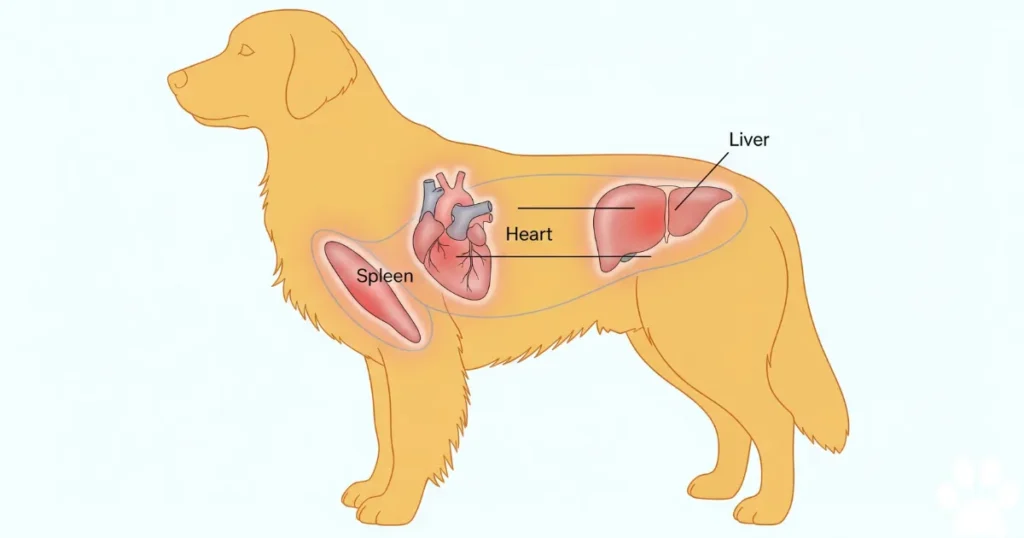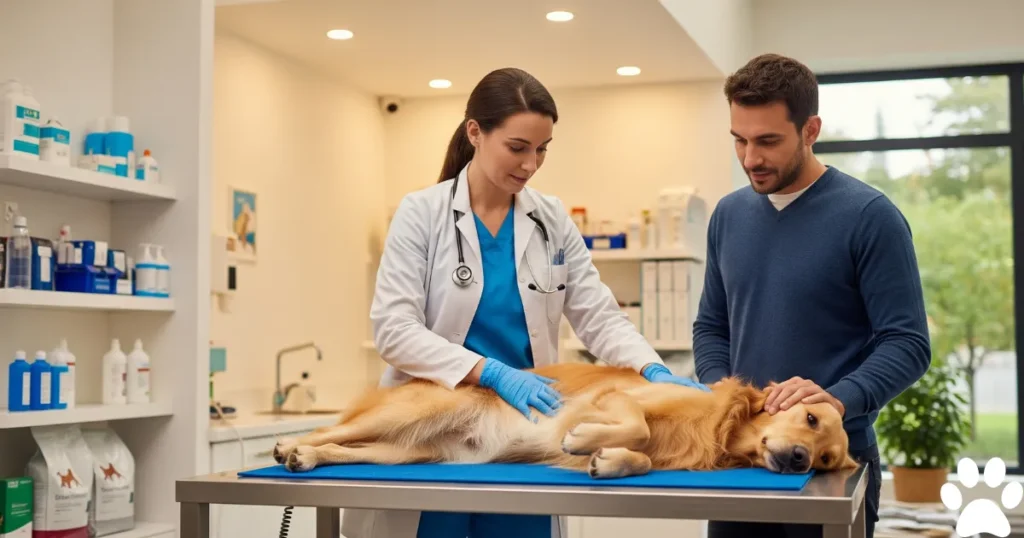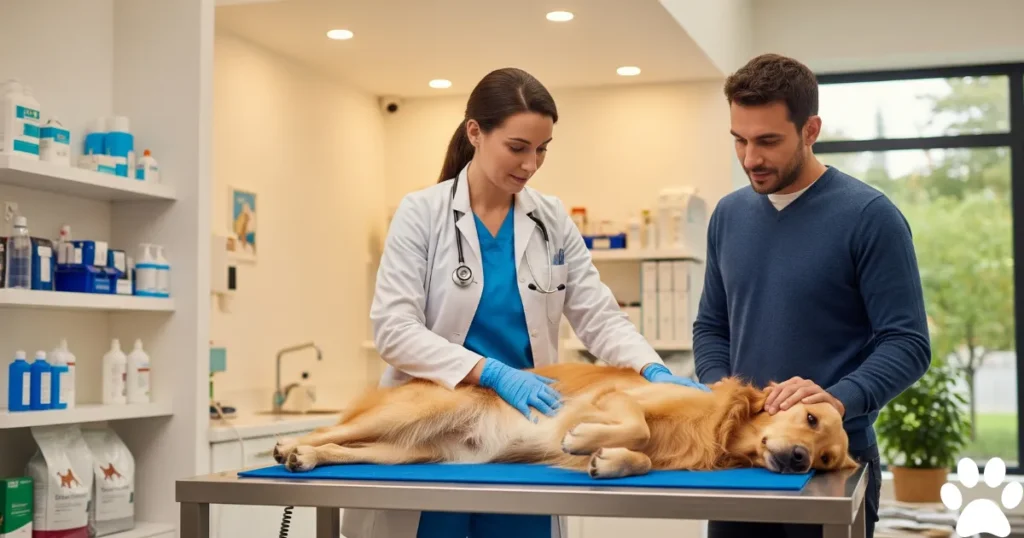Recognizing the signs dog dying hemangiosarcoma is one of the most heartbreaking yet important skills a Golden Retriever owner can develop. Hemangiosarcoma, a highly aggressive blood vessel cancer, affects Golden Retrievers at alarmingly high rates, making this knowledge crucial for providing compassionate end-of-life care when this devastating disease reaches its final stages.
Understanding the signs dog dying hemangiosarcoma empowers owners to make informed decisions about comfort care, pain management, and end-of-life planning while ensuring their beloved Golden Retriever receives the dignity and love they deserve during their final journey. This knowledge, though difficult to face, provides the foundation for meaningful decision-making during an emotionally challenging time.
This comprehensive guide offers practical insights, emotional support, and clinical understanding to help Golden Retriever families recognize when their companion is approaching the end stages of hemangiosarcoma, along with guidance on providing compassionate care that prioritizes comfort and quality of life over prolonging suffering.
Contents
- 1 Understanding Hemangiosarcoma in Golden Retrievers
- 2 Early End-Stage Warning Signs
- 3 Cardiovascular System Decline
- 4 Respiratory and Metabolic Changes
- 5 Pain and Discomfort Assessment
- 6 Crisis Recognition and Emergency Signs
- 7 Quality of Life Evaluation
- 8 End-of-Life Decision Making
- 9 Comfort Care and Palliative Support.
- 10 Supporting Family Through the Journey
- 10.1 Emotional Preparation and Communication
- 10.2 Creating Lasting Memories
- 10.3 What are the most obvious signs dog dying hemangiosarcoma?
- 10.4 How quickly do dogs decline with end-stage hemangiosarcoma?
- 10.5 Can hemangiosarcoma cause sudden death without warning?
- 10.6 How can I tell if my Golden Retriever is suffering from hemangiosarcoma?
- 10.7 Should I pursue emergency treatment for bleeding episodes?
- 10.8 What should I expect during the final days of hemangiosarcoma?
- 10.9 Is it better to euthanize before a crisis or wait?
- 10.10 How can I provide the best comfort care at home?
- 11 Final Thoughts
Understanding Hemangiosarcoma in Golden Retrievers
Hemangiosarcoma represents one of the most aggressive cancers affecting Golden Retrievers, with this breed showing a genetic predisposition that makes them significantly more susceptible than most other dog breeds. This cancer develops in blood vessel walls and can occur in various organs, most commonly the spleen, heart, and liver.
The signs dog dying hemangiosarcoma often develop rapidly and unpredictably, as this cancer tends to progress quickly once it reaches advanced stages. Unlike some cancers that allow for months of gradual decline, hemangiosarcoma can cause sudden, dramatic changes in a dog’s condition within days or even hours.
Golden Retrievers with hemangiosarcoma face unique challenges due to the cancer’s tendency to cause internal bleeding, which can be life-threatening without warning. The unpredictable nature of bleeding episodes makes this cancer particularly difficult for families to manage and emotionally devastating when crisis situations arise unexpectedly.
The location of hemangiosarcoma tumors significantly influences the signs dog dying hemangiosarcoma that owners observe. Splenic tumors may cause abdominal symptoms, cardiac tumors affect heart function, and liver involvement creates digestive complications, each requiring different approaches to comfort care and symptom management. Also, focus on any signs of cancer in dogs.

Early End-Stage Warning Signs
Sudden Collapse Episodes
One of the most characteristic signs dog dying hemangiosarcoma involves sudden collapse episodes that occur without obvious triggers. These episodes result from internal bleeding when tumors rupture or leak, causing rapid blood loss that leads to weakness, shock, and potential loss of consciousness.
Collapse episodes typically present as:
- Sudden weakness or inability to stand without warning
- Loss of consciousness or disorientation
- Pale or white gums indicating severe blood loss
- Rapid, weak pulse or irregular heartbeat
- Cold extremities and shivering
- Difficulty breathing or panting
These episodes may be followed by apparent recovery as the dog’s body compensates for blood loss, creating a false sense of improvement. However, repeated episodes indicate continued tumor bleeding and disease progression, making each subsequent episode potentially more severe than the last.
Progressive Weakness and Lethargy
Beyond acute collapse episodes, signs dog dying hemangiosarcoma include progressive weakness that gradually limits a Golden Retriever’s health and ability to participate in normal activities. This weakness stems from chronic anemia, reduced oxygen-carrying capacity, and the cancer’s metabolic demands on the body.
Progressive weakness manifests as:
- Increasing reluctance to exercise or engage in play
- Difficulty rising from lying positions
- Shortened walks with frequent rest breaks
- Loss of interest in favorite activities and toys
- Extended periods of sleeping or resting
- Reduced responsiveness to family interaction
The gradual nature of this weakness often makes it difficult for owners to recognize initially, as Golden Retrievers may continue attempting normal activities despite feeling increasingly unwell. Careful observation of energy levels and enthusiasm helps identify these subtle but significant changes.

Cardiovascular System Decline
Internal Bleeding Complications
The most dangerous aspect of signs dog dying hemangiosarcoma involves internal bleeding complications that can range from slow, chronic blood loss to sudden, massive hemorrhage. These bleeding episodes occur when tumors grow large enough to rupture or when smaller vessels feeding the tumor break under pressure.
Internal bleeding signs include:
- Gradual development of pale gums over hours or days
- Abdominal distension that may come and go
- Weakness that worsens progressively without other obvious causes
- Loss of appetite accompanied by nausea
- Restlessness and inability to find comfortable positions
- Dark, tarry stools indicating blood in the digestive system
The unpredictable nature of bleeding episodes creates significant stress for families, as dogs may seem stable one moment and experience life-threatening complications the next. Understanding these patterns helps owners prepare for potential emergencies and make informed care decisions.
Circulation and Oxygen Transport Problems
Signs dog dying hemangiosarcoma inevitably include severe anemia as the cancer destroys red blood cells faster than the body can replace them. This anemia creates widespread oxygen delivery problems that affect every organ system and contribute to the overall decline in quality of life.
Circulation-related symptoms include:
- Extreme fatigue and weakness even with minimal activity
- Rapid heart rate as the cardiovascular system works harder
- Breathing difficulties, particularly during mild exertion
- Cold intolerance and frequent shivering episodes
- Mental dullness or confusion due to reduced brain oxygen
- Delayed wound healing and increased susceptibility to infections
The severity of anemia often serves as a reliable indicator of disease progression, with severely anemic dogs facing significant quality of life limitations that impact their ability to enjoy basic activities or maintain comfort.

Respiratory and Metabolic Changes
Breathing Difficulties
As hemangiosarcoma progresses, signs dog dying hemangiosarcoma often include respiratory complications that result from anemia, heart strain, or direct tumor effects on circulation. These breathing changes can range from subtle increases in respiratory rate to obvious labored breathing at rest.
Respiratory symptoms include:
- Increased breathing rate even during rest periods
- Labored or effortful breathing patterns
- Preference for sitting or standing rather than lying down
- Reluctance to engage in any physical activity
- Pale or blue-tinged gums indicating poor oxygenation
- Persistent panting that doesn’t respond to cooling measures
These respiratory changes often worsen gradually but can deteriorate rapidly during bleeding episodes or when anemia becomes severe. Monitoring breathing patterns helps assess comfort levels and guide decisions about pain management and quality of life.
Appetite and Digestive Changes
Signs dog dying hemangiosarcoma frequently involve significant changes in appetite and digestion as the cancer affects multiple body systems simultaneously. The combination of anemia, medication side effects, and general illness creates complex nutritional challenges that impact overall wellbeing.
Digestive symptoms include:
- Complete loss of interest in regular food and treats
- Nausea and vomiting, particularly after eating attempts
- Difficulty keeping food or water down
- Preference for liquid nutrition over solid foods
- Rapid weight loss despite nutritional support efforts
- Changes in bowel movements or bathroom habits
These feeding difficulties often cause significant distress for families who want to provide comfort through food offerings. However, forcing nutrition during end-stage disease may increase discomfort without providing meaningful benefit to the dog’s overall condition.
Pain and Discomfort Assessment
Understanding Hemangiosarcoma Pain
Pain management represents a crucial aspect of recognizing signs dog dying hemangiosarcoma, as this cancer can cause multiple types of discomfort simultaneously. Golden Retrievers may experience acute pain during bleeding episodes, chronic discomfort from tumor pressure, and generalized pain from severe anemia and organ dysfunction.
Pain indicators specific to hemangiosarcoma include:
- Restlessness and inability to settle into comfortable positions
- Reluctance to lie down or difficulty finding comfortable resting positions
- Sensitivity to touch, particularly around the abdomen or affected areas
- Changes in facial expression, including furrowed brow or tense features
- Panting at rest, especially when combined with other symptoms
- Altered sleep patterns and frequent position changes during rest
Golden Retrievers often attempt to hide their discomfort, making careful observation of subtle behavioral changes essential for accurate pain assessment. Changes in normal routines, interaction patterns, and response to affection may indicate pain levels more reliably than obvious distress signals.
Behavioral Changes Indicating Distress
Signs dog dying hemangiosarcoma include behavioral changes that reflect your Golden Retriever’s declining comfort and overall wellbeing. These changes may be gradual initially but often become more pronounced as the disease progresses and discomfort increases.
Behavioral indicators of distress include:
- Withdrawal from family activities and social interactions
- Loss of interest in previously enjoyed activities or toys
- Changes in sleep patterns, including restlessness or excessive sleeping
- Reduced response to calls, commands, or family members
- Irritability or sensitivity when touched or approached
- Confusion or disorientation during familiar routines
These behavioral changes often serve as reliable indicators of disease progression, as Golden Retrievers naturally seek comfort and companionship even when feeling unwell. Significant changes in personality or social engagement may indicate that discomfort is outweighing quality of life benefits.

Crisis Recognition and Emergency Signs
Acute Bleeding Episodes
The most critical signs dog dying hemangiosarcoma involve acute bleeding episodes that require immediate recognition and potential emergency intervention. These episodes can be life-threatening and may occur with little warning, making family preparedness essential for appropriate response.
Emergency bleeding signs include:
- Sudden collapse or loss of consciousness
- Extremely pale or white gums and tongue
- Rapid, thready pulse that may be difficult to detect
- Severe abdominal distension that develops quickly
- Cold body temperature and uncontrollable shivering
- Disorientation or unresponsiveness to stimulation
These crisis episodes often occur unexpectedly, even in dogs who seemed stable hours earlier. Understanding these warning signs helps families make rapid decisions about emergency veterinary care versus comfort care, depending on their previously established treatment goals and quality of life priorities.
Shock and Cardiovascular Collapse
Signs dog dying hemangiosarcoma may include shock and cardiovascular collapse when bleeding becomes severe enough to compromise vital organ function. These symptoms represent medical emergencies that require immediate attention if families choose to pursue emergency treatment.
Shock symptoms include:
- Weakness so severe the dog can not rise or stand
- Breathing that becomes shallow, rapid, or irregular
- Heart rate that becomes very fast, very slow, or irregular
- Body temperature that drops below normal ranges
- Loss of bladder or bowel control
- Decreased awareness of surroundings or family members
Recognizing these signs helps families understand when their Golden Retriever may be experiencing life-threatening complications, allowing for informed decisions about emergency intervention versus compassionate end-of-life care based on previously established treatment goals.

Quality of Life Evaluation
Mobility and Independence Assessment
Assessing quality of life when observing signs dog dying hemangiosarcoma requires honest evaluation of your Golden Retriever’s ability to maintain basic functions and experience joy in simple activities. Mobility limitations often signal significant disease progression and directly impact overall wellbeing.
Key mobility factors to evaluate include:
- Ability to rise and move without obvious distress
- Interest in short walks or brief outdoor exploration
- Capacity to reach food, water, and elimination areas independently
- Comfort when resting in various positions throughout the day
- Response to gentle physical interaction and affection
- Maintenance of basic hygiene and grooming behaviors
Golden Retrievers naturally want to please their families and may attempt activities beyond their current capabilities. Distinguishing between determined effort and genuine comfort with movement helps guide realistic quality of life assessments during this difficult time.
Social and Emotional Engagement
Signs dog dying hemangiosarcoma often affect your Golden Retriever’s emotional state and social interactions with family members. These changes may be subtle initially but typically become more pronounced as discomfort increases and energy levels decline.
Social engagement indicators include:
- Interest in family activities and household routines
- Response to favorite people arriving home or calling their name
- Willingness to accept physical affection and gentle petting
- Participation in simple, low-energy family interactions
- Alertness and awareness of immediate surroundings
- Retention of personality traits and individual preferences
Loss of interest in social interaction often indicates significant discomfort or disease progression, as Golden Retrievers naturally seek companionship and family involvement even when feeling unwell. Significant changes in social responsiveness may signal that quality of life is declining substantially.

End-of-Life Decision Making
Recognizing When Suffering Outweighs Quality of Life
Making end-of-life decisions based on signs dog dying hemangiosarcoma requires balancing deep love for your Golden Retriever with realistic assessment of their comfort, dignity, and overall quality of life. The goal is preventing unnecessary suffering while honoring the special bond shared between family and pet.
Consider end-of-life options when:
- Bleeding episodes become frequent, severe, or difficult to manage
- Pain can not be adequately controlled with available medications
- Your Golden Retriever shows no interest in food, water, or family interaction
- Breathing becomes consistently labored, even during rest periods
- Mobility is severely compromised and basic comfort can not be maintained
- Crisis episodes occur frequently, causing repeated distress
These decisions often involve weighing brief periods of apparent stability against increasing episodes of distress, requiring families to focus on overall trends and patterns rather than momentary improvements that may not reflect long-term comfort.
Euthanasia Considerations and Planning
When signs dog dying hemangiosarcoma progress beyond manageable comfort levels, euthanasia provides a peaceful, dignified end to suffering. This profound decision reflects deep love and commitment to your Golden Retriever’s wellbeing rather than personal desires to extend time together.
Euthanasia planning considerations include:
- Timing decisions based on quality of life assessment rather than arbitrary timelines
- Location preferences for the procedure (familiar home environment vs. veterinary clinic).
- Family members who wish to be present during the final moments.
- Special preparations, rituals, or comfort items that provide peace.
- Aftercare planning and decisions about your dog’s remains.
- Memorial arrangements to honor your companion’s life and legacy.
Many families benefit from discussing these difficult decisions before crisis situations arise, allowing for thoughtful planning rather than emergency decision-making during acute bleeding episodes or other medical emergencies.
Comfort Care and Palliative Support.
Home Environment Modifications.
Providing optimal comfort care when observing signs dog dying hemangiosarcoma involves creating a supportive home environment that accommodates your Golden Retriever’s changing needs while preserving dignity and familiar routines as much as possible.
Environment modifications include:
- Soft, supportive bedding to reduce pressure points and increase comfort.
- Easy access to food, water, and elimination areas without requiring extensive movement.
- Temperature control to accommodate poor circulation and cold sensitivity.
- Quiet spaces that allow for undisturbed rest away from household activity.
- Non-slip surfaces to prevent falls and provide secure footing.
- Familiar items like favorite blankets, toys, or resting spots.
These modifications help maintain comfort while allowing your Golden Retriever to remain in familiar surroundings with beloved family members during their final weeks or months.
Pain Management and Medication Support
Managing discomfort associated with signs dog dying hemangiosarcoma requires working closely with veterinary professionals to develop appropriate pain management protocols that prioritize comfort while considering medication limitations imposed by the cancer’s effects on organ function.
Pain management strategies may include:
- Opioid medications for severe pain relief when kidney function permits.
- Anti-inflammatory drugs used cautiously due to bleeding risks.
- Gabapentin for nerve-related pain and general discomfort.
- Tramadol for moderate pain management with fewer side effects.
- Complementary therapies like gentle massage or acupuncture.
- Environmental modifications to reduce movement-related discomfort.
Medication effectiveness may change as the disease progresses, requiring frequent communication with veterinary professionals to adjust protocols and maintain optimal comfort levels throughout the end-of-life journey.

Supporting Family Through the Journey
Emotional Preparation and Communication
Observing signs dog dying hemangiosarcoma affects entire families, requiring emotional preparation and open communication to help all members process grief while making important decisions about their beloved Golden Retriever’s care and comfort.
Family support strategies include:
- Honest, age-appropriate discussions about the dog’s condition and prognosis.
- Involving family members in comfort care activities when appropriate.
- Creating opportunities for meaningful bonding time and special memories.
- Explaining disease progression and end-of-life signs in understandable terms.
- Providing emotional support resources for family members struggling with anticipatory grief.
- Planning memorial activities to honor the dog’s life and impact on the family.
Professional counseling, pet loss support groups, and veterinary social workers can provide valuable guidance for families navigating the complex emotions associated with end-of-life decisions and anticipatory grief.
Creating Lasting Memories
During the time when signs dog dying hemangiosarcoma become apparent, focusing on creating positive memories helps families process grief while celebrating their Golden Retriever’s life and unique personality. These activities provide comfort and meaning during difficult times.
Memory-making activities include:
- Professional photography sessions capturing special moments and family bonds.
- Paw print or nose print impressions for lasting keepsakes.
- Writing letters, journals, or stories about favorite memories and personality traits.
- Creating photo albums, scrapbooks, or digital memory collections.
- Recording videos that capture your dog’s unique behaviors and personality.
- Sharing stories about your Golden Retriever’s impact on family life.
These activities help families focus on celebration and gratitude rather than solely on loss, providing positive coping mechanisms and lasting tributes to honor their companion’s memory and legacy.
What are the most obvious signs dog dying hemangiosarcoma?
The most obvious signs dog dying hemangiosarcoma include sudden collapse episodes, extremely pale gums, severe weakness, difficulty breathing, loss of appetite, and episodes of internal bleeding. These symptoms often develop rapidly and may occur without warning, making recognition crucial for appropriate care decisions.
How quickly do dogs decline with end-stage hemangiosarcoma?
Signs dog dying hemangiosarcoma can develop rapidly, with some Golden Retrievers declining significantly within days or weeks of diagnosis. The unpredictable nature of internal bleeding makes it difficult to predict exact timelines, but most dogs with advanced hemangiosarcoma survive weeks to a few months with palliative care.
Can hemangiosarcoma cause sudden death without warning?
Yes, signs dog dying hemangiosarcoma can include sudden death due to massive internal bleeding when large tumors rupture. This complication can occur with little warning, making it important for families to understand the risks and consider quality of life decisions proactively.
How can I tell if my Golden Retriever is suffering from hemangiosarcoma?
Signs dog dying hemangiosarcoma that indicate suffering include persistent restlessness, inability to get comfortable, labored breathing, extreme weakness, loss of interest in all activities, and obvious pain responses. Quality of life assessment tools can help evaluate suffering levels objectively.
Should I pursue emergency treatment for bleeding episodes?
Treatment decisions during signs dog dying hemangiosarcoma should be based on previously established goals, quality of life assessment, and realistic prognosis. Many families choose comfort care over aggressive emergency treatment when dogs are in advanced stages of disease.
What should I expect during the final days of hemangiosarcoma?
During the final stages when signs dog dying hemangiosarcoma are most apparent, expect increasing weakness, decreased responsiveness, difficulty breathing, and possible bleeding episodes. Many dogs become increasingly sleepy and less aware of their surroundings as body systems shut down.
Is it better to euthanize before a crisis or wait?
Most veterinarians recommend considering euthanasia before crisis situations when observing signs dog dying hemangiosarcoma to prevent unnecessary suffering. Waiting for natural death may result in painful bleeding episodes or distressing symptoms that could be prevented through compassionate euthanasia.
How can I provide the best comfort care at home?
Optimal comfort care during signs dog dying hemangiosarcoma involves maintaining a quiet, comfortable environment, providing easy access to necessities, managing pain medications as prescribed, offering gentle companionship, and respecting your dog’s need for rest while ensuring they don’t feel abandoned.
Final Thoughts
Recognizing signs dog dying hemangiosarcoma empowers Golden Retriever families to provide compassionate, informed care during one of life’s most challenging experiences. While this knowledge is heartbreaking to acquire, understanding these signs allows families to focus on comfort, dignity, and meaningful time together rather than being overwhelmed by uncertainty and fear.
Remember that every Golden Retriever’s experience with end-stage hemangiosarcoma is unique, and your dog’s symptoms and timeline may differ from typical patterns. The most important considerations are maintaining quality of life, preventing unnecessary suffering, and honoring the special bond that has enriched your lives together.
Throughout the journey of observing signs dog dying hemangiosarcoma, trust your instincts as a loving pet owner while working closely with veterinary professionals to make decisions that prioritize your Golden Retriever’s wellbeing and comfort. The courage to face this difficult time with compassion reflects the profound love that defines the human-canine relationship.
Focus on the joy, love, and countless precious memories your Golden Retriever has brought to your family. While saying goodbye is devastating, the bond you share transcends physical limitations, creating a lasting legacy of love that honors your companion’s life and the privilege of sharing this journey together.
Dr. Nabeel A.
Hi, I’m Dr. Nabeel Akram – a farm management professional by trade and a passionate Golden Retriever enthusiast at heart. With years of experience in animal science and livestock care, I’ve built a career around understanding animals—how they live, thrive, and bring value to our lives. This blog is a personal project born from that same passion, focusing on one of the most loyal and lovable breeds out there: the Golden Retriever. Whether I’m managing farm operations or sharing insights on canine health, behavior, and care, it all ties back to one core belief—animals deserve thoughtful, informed, and compassionate attention. Welcome to a space where professional expertise meets genuine love for dogs.
Facebook |


Links will be automatically removed from comments.